PsychNewsDaily Publishers
100 Summit Drive
Burlington, MA, 01803
Telephone: (320) 349-2484
PsychNewsDaily Publishers
100 Summit Drive
Burlington, MA, 01803
Telephone: (320) 349-2484
Making your own cat furniture allows for creativity, customization, and cost-saving, providing your cat with engaging spaces while enhancing your home’s aesthetic.
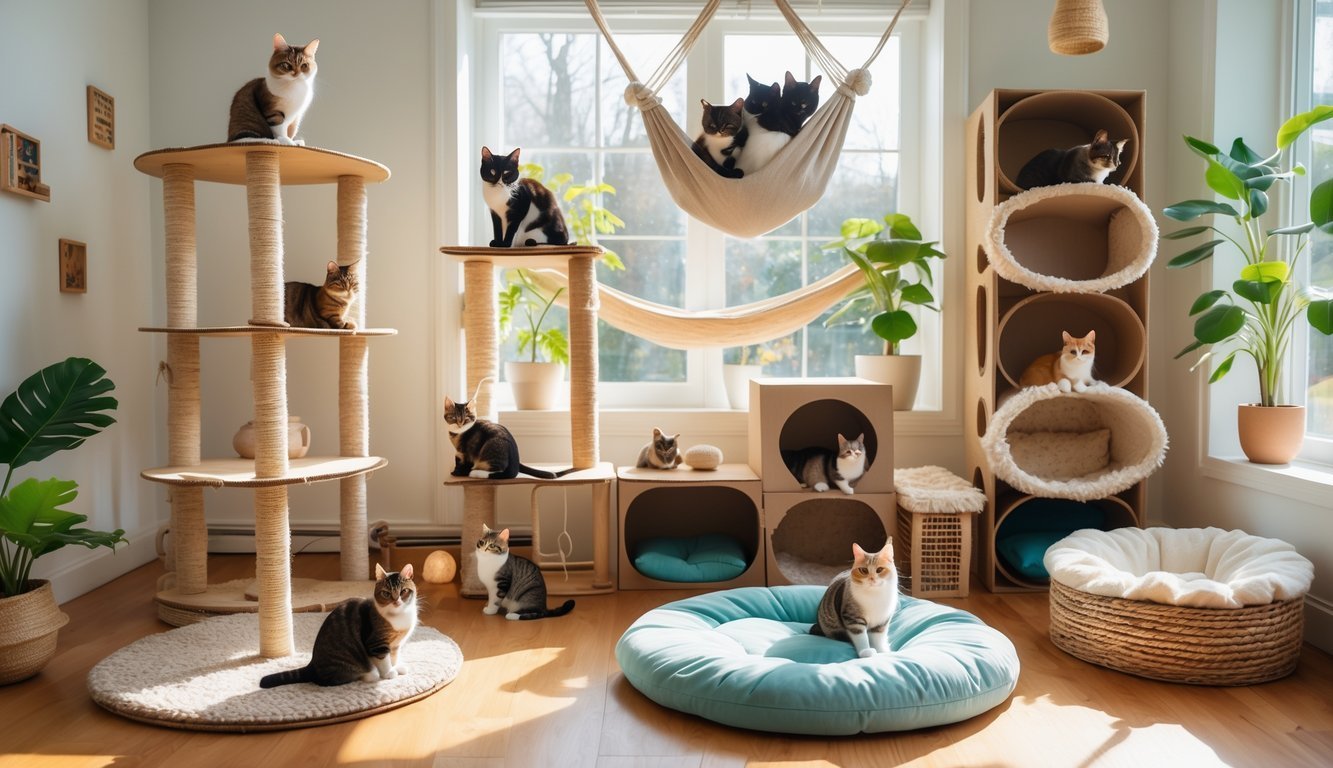
Making your own cat furniture? It’s a chance to get creative, save some cash, and actually make stuff your cat will use. Forget those expensive towers or beds that never match your style. You can build things that fit your space and look good in your home.
You get to design furniture that keeps your cat happy while making your home look good.
With just a few tools and a little imagination, you can create climbing spots, scratching posts, and cozy hideouts your cat will actually use. Each idea here gives your cat a place to play or nap, and you won’t have to sacrifice your home’s vibe.
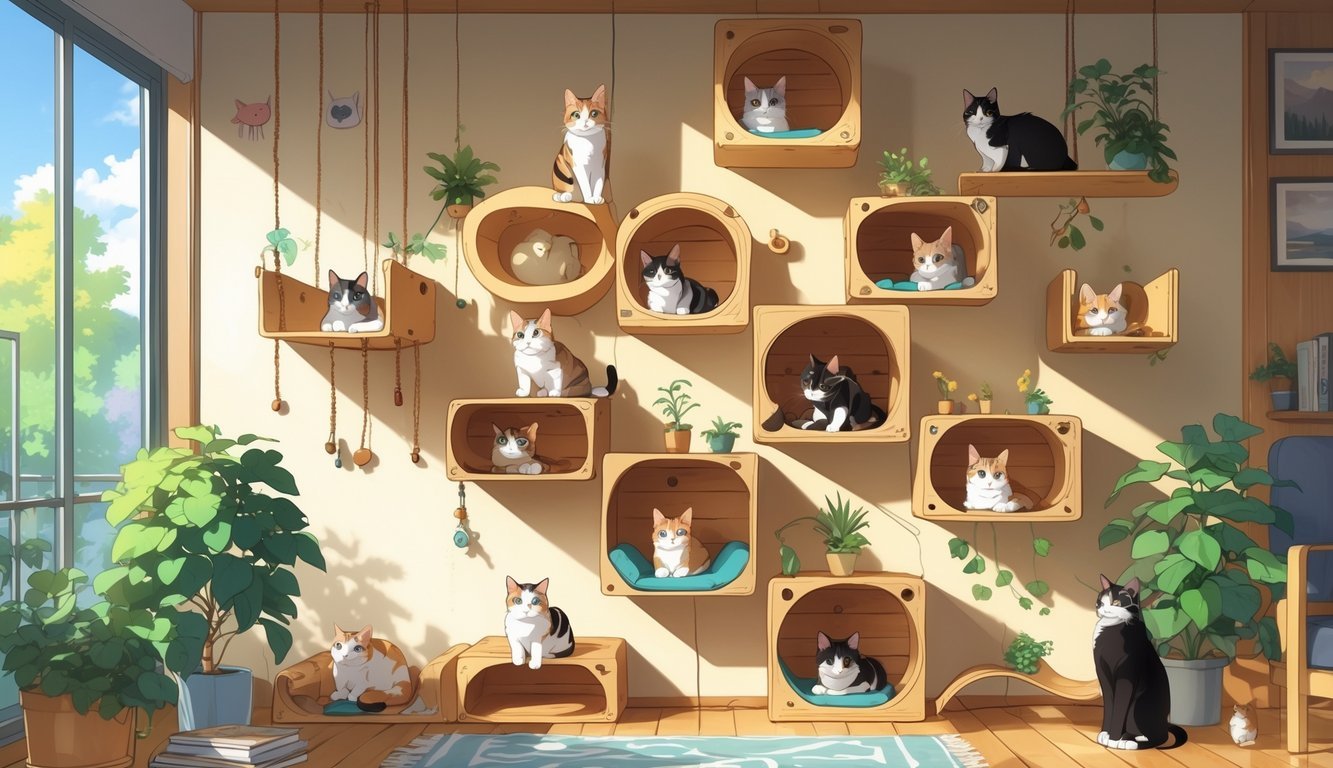
Add wall-mounted shelves and your cat suddenly gets a whole new world to climb. These shelves let your cat go vertical, which is perfect if you don’t have a ton of floor space. They’re a lifesaver in apartments.
Grab some sturdy wooden boards and strong brackets. Make sure the shelves are big enough for your cat to sit or stretch out. Attach them to wall studs so they stay put.
Arrange the shelves like steps so your cat can hop from one to another. This setup encourages exercise and keeps your cat entertained.
Place soft fabric, carpet squares, or cushions on top to make the shelves extra comfy. You can wrap parts with sisal rope for scratching—your furniture will thank you.
Think about placement. Cats love high spots where they can watch everything. If you put shelves near a window, your cat gets a front-row seat to the outside world.
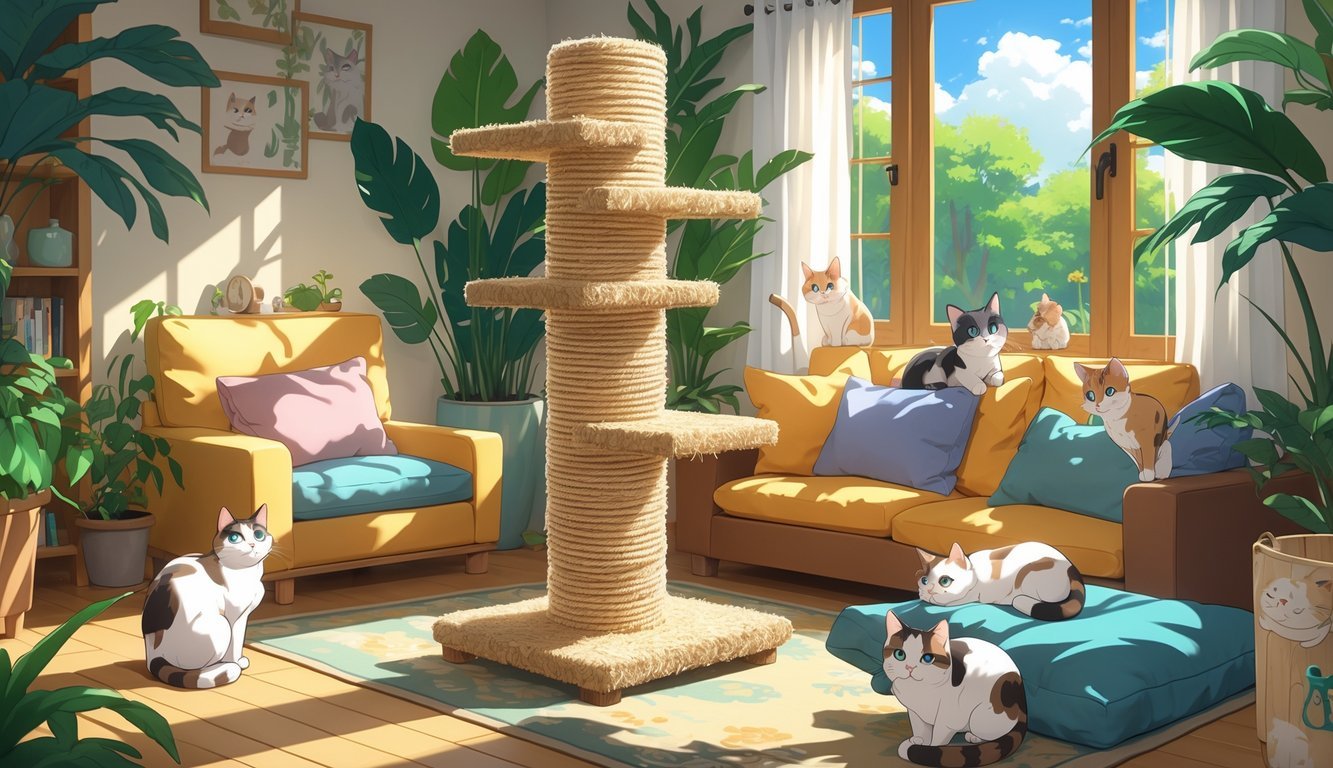
A sisal rope scratching post is a classic for a reason. Cats need to scratch, and sisal rope makes the perfect surface. You’ll save your couch and give your cat a safe place to dig in those claws.
Grab a solid wooden base, a sturdy post, and lots of sisal rope. Make the base about 18–20 inches square so it won’t tip over. For height, aim for 30–36 inches so your cat can stretch all the way up.
Wrap the post tightly with sisal rope, using glue or staples to keep it in place. Make sure the rope is snug so it doesn’t slip.
Want to make it fancier? Add a small platform on top for lounging. You can even hang a toy or feather to keep things interesting. Set the post where your cat already hangs out.
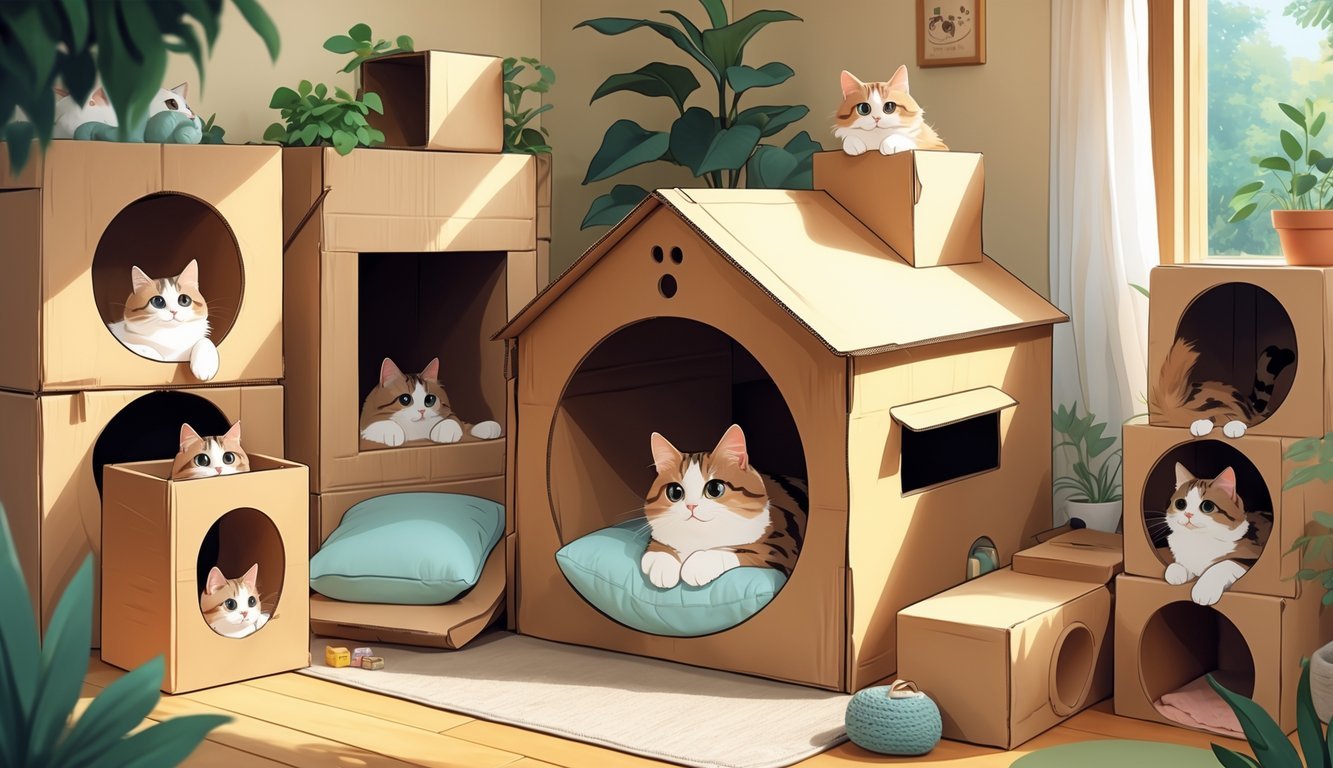
Turn a cardboard box into a cozy cat house with just a few cuts and some tape. Cats are obsessed with boxes, so this is a no-brainer.
Pick a sturdy box big enough for your cat to move around. Cut out a doorway that’s easy for your cat to enter but still feels private.
Decorate the outside with wrapping paper, fabric, or paint if you want it to blend in with your space. Toss a soft blanket or pillow inside for extra comfort.
Feeling ambitious? Stack a couple of boxes for a two-story hideout. Just make sure you tape everything well so it stays together.
This project barely costs anything and lets you reuse stuff you already have. It’s simple, but your cat will love it.
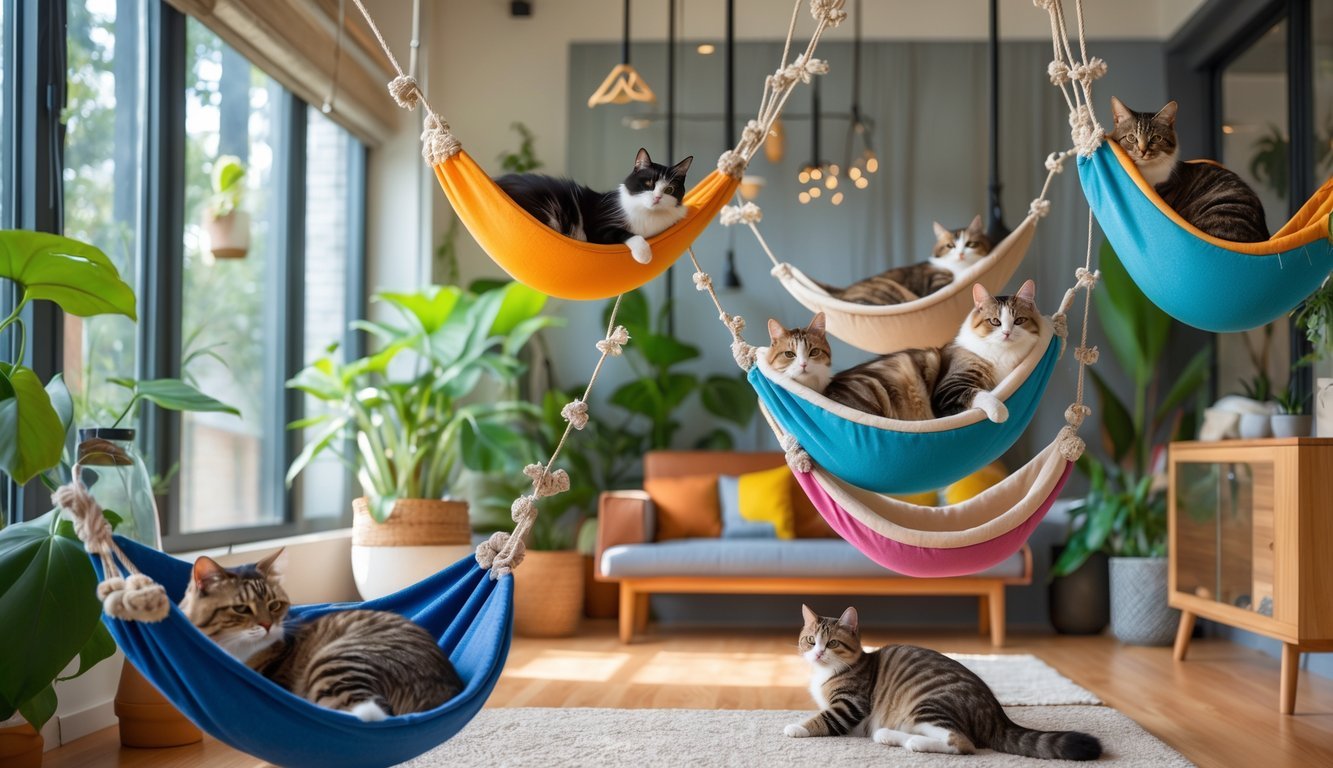
A hanging cat hammock gives your cat a cozy spot to chill while keeping your floor clear. You can hang one under a chair, inside a frame, or even on the wall if you’ve got strong supports.
You just need sturdy fabric, some hooks, and strong straps or rope. Cotton, canvas, or fleece all work—they’re soft and easy to clean.
Your cat will love hanging out above the ground, and honestly, it looks pretty cool in your living room. It’s an easy project and you can adjust it to fit your style or your cat’s size.
Want to get creative? Repurpose a side table or shelf by adding fabric underneath. Suddenly, you’ve got a hammock that fits right in with your furniture.
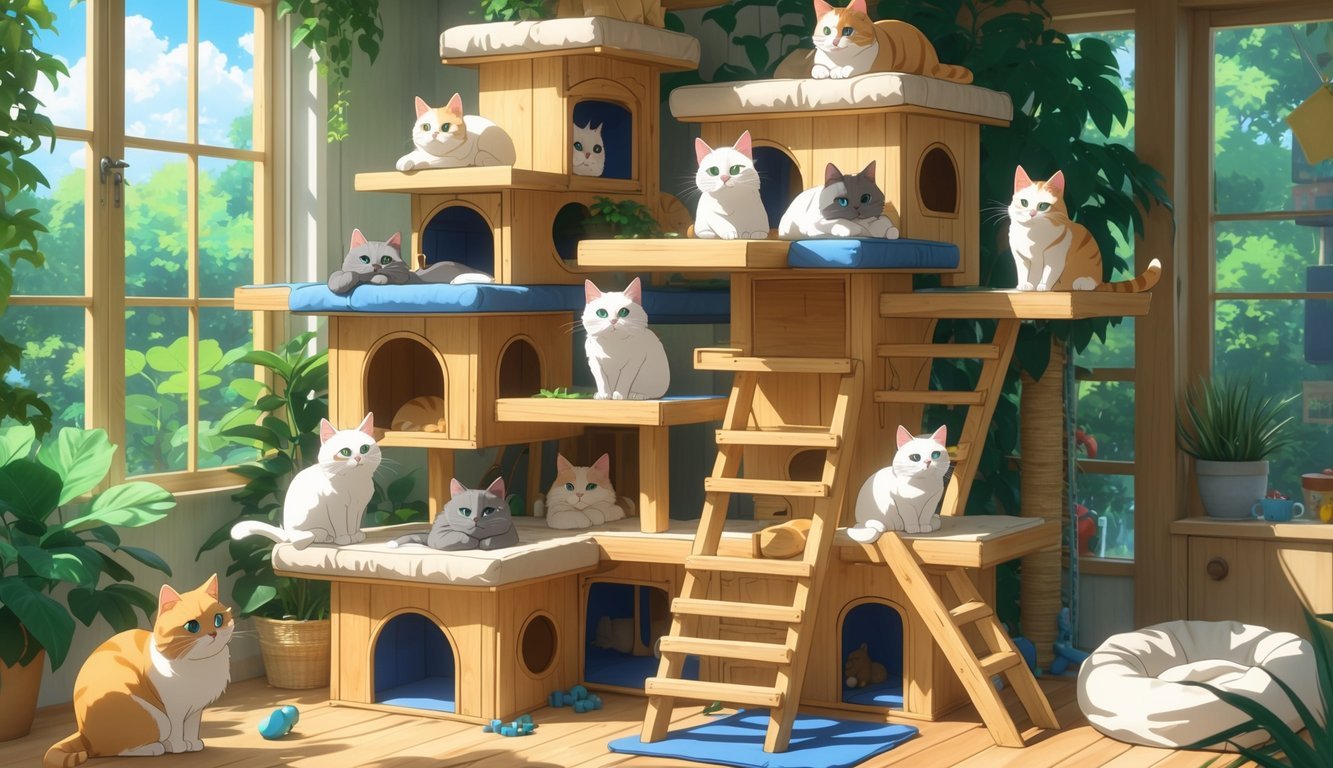
A multi-level cat tree gives your cat places to climb, scratch, and nap. Add some hideouts, and your cat gets cozy little retreats for when it wants some alone time.
Build it with sturdy wood, plywood, or MDF for the base and levels. Wrap the posts in sisal rope so your cat has plenty of places to scratch.
Add carpet or fabric to the platforms for extra comfort. Use small boxes or cubes as hideouts on the lower levels.
Put the tree near a wall or window so your cat can enjoy the view from up high. This setup gives your cat exercise and a safe spot to keep an eye on everything.
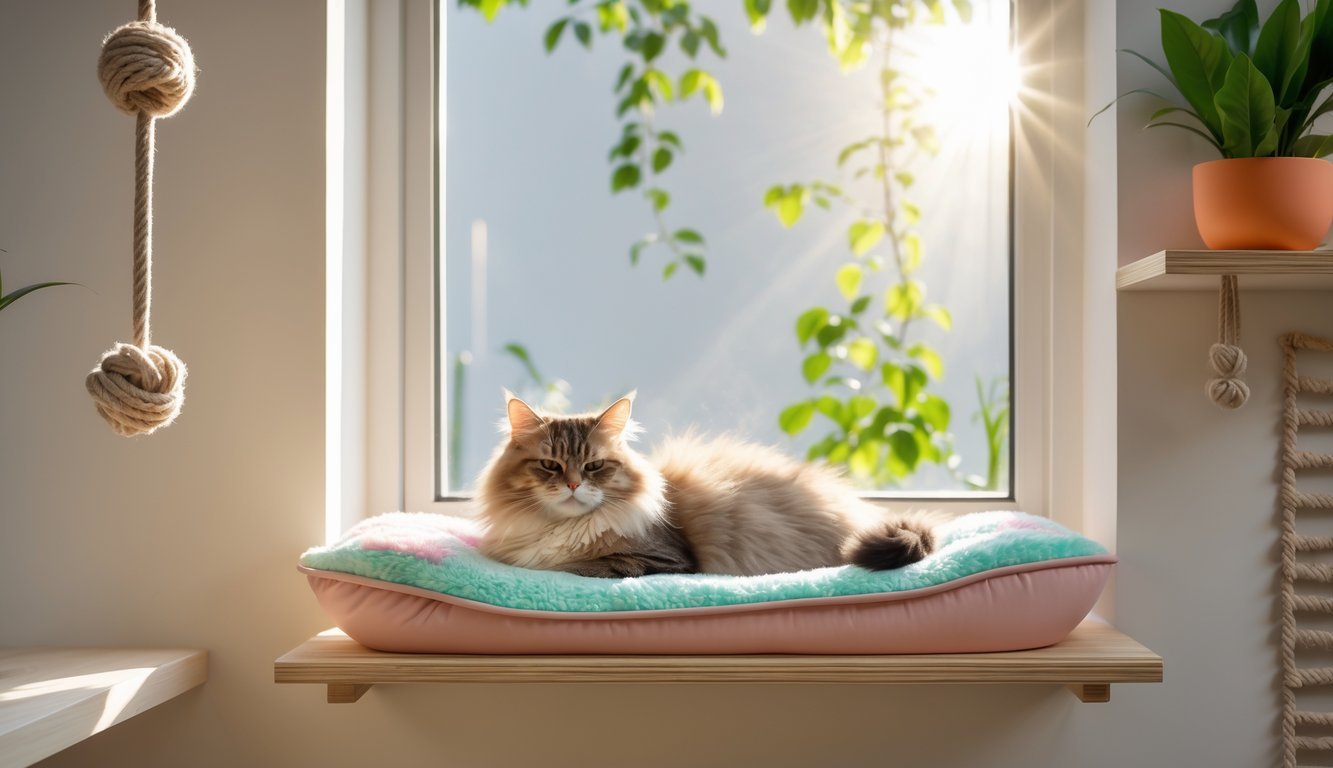
A window perch is a game changer for indoor cats. They get a comfy spot to relax and watch the world go by. You can make one with a wooden board, sturdy brackets, and a soft cushion.
Measure your window sill first so the perch fits. Use two L-brackets to support the board and screw them in tightly beneath the sill.
Sand any rough edges so your cat doesn’t get scratched. Top it off with a cushion, folded blanket, or even a thick towel.
Cover the cushion with washable fabric to keep things clean. Go for something soft—your cat will appreciate it.
This perch works best for cats who love sunbathing or birdwatching. It doesn’t take up any floor space since it’s right on the window.
With just a little work, you’ll have a spot your cat might never want to leave.
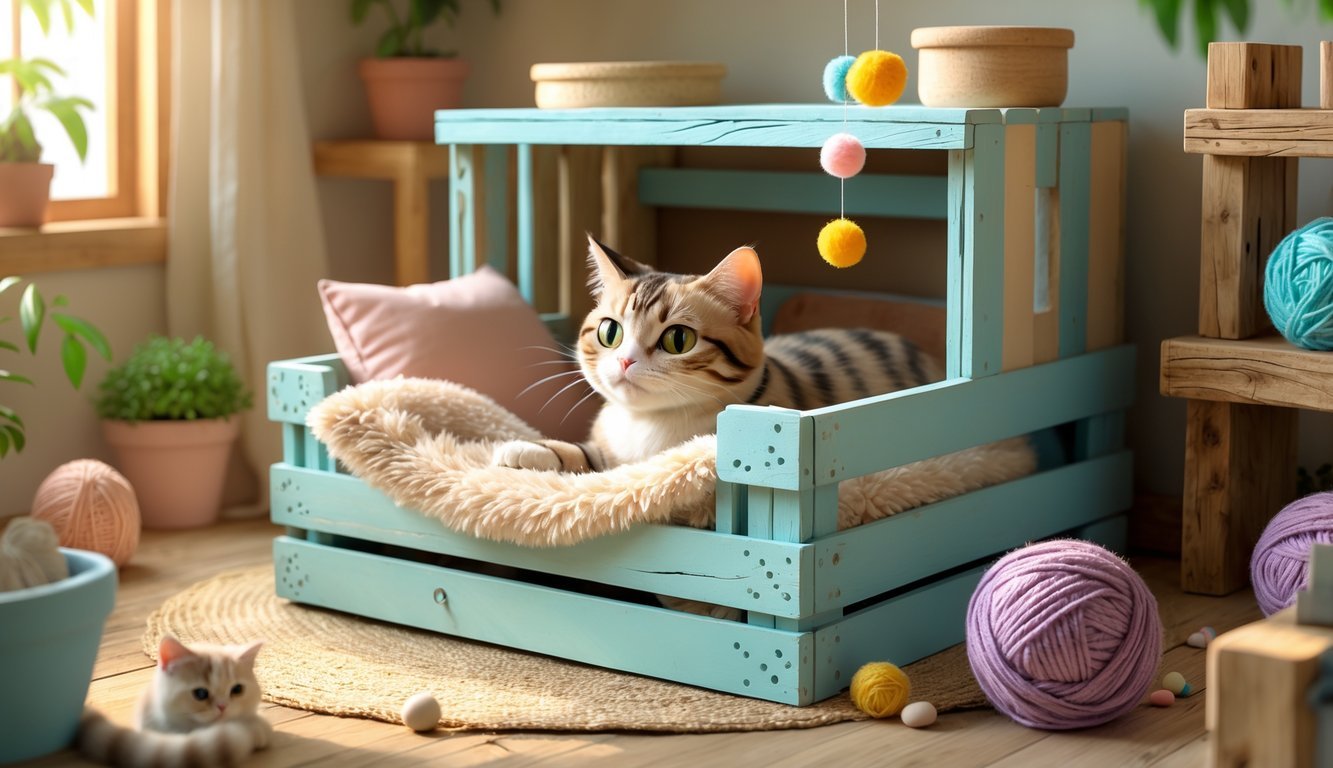
Turn a wooden crate into a cozy cat bed in no time. You can find crates at craft stores, thrift shops, or maybe even your garage. They’re sturdy and make a perfect base for a comfy spot.
Sand down any rough edges so your cat stays safe. Paint or stain the crate if you want it to match your room. Throw in a soft cushion or folded blanket, and it’s ready for lounging.
If you want to get fancy, add little legs to lift the crate off the ground. Cats love a bit of extra height. You can also line the inside with fabric for a polished look.
Customize the crate to fit your space. Whether it’s in the living room, bedroom, or even a covered porch, you’ll have a simple project that gives your cat a cozy place to relax.
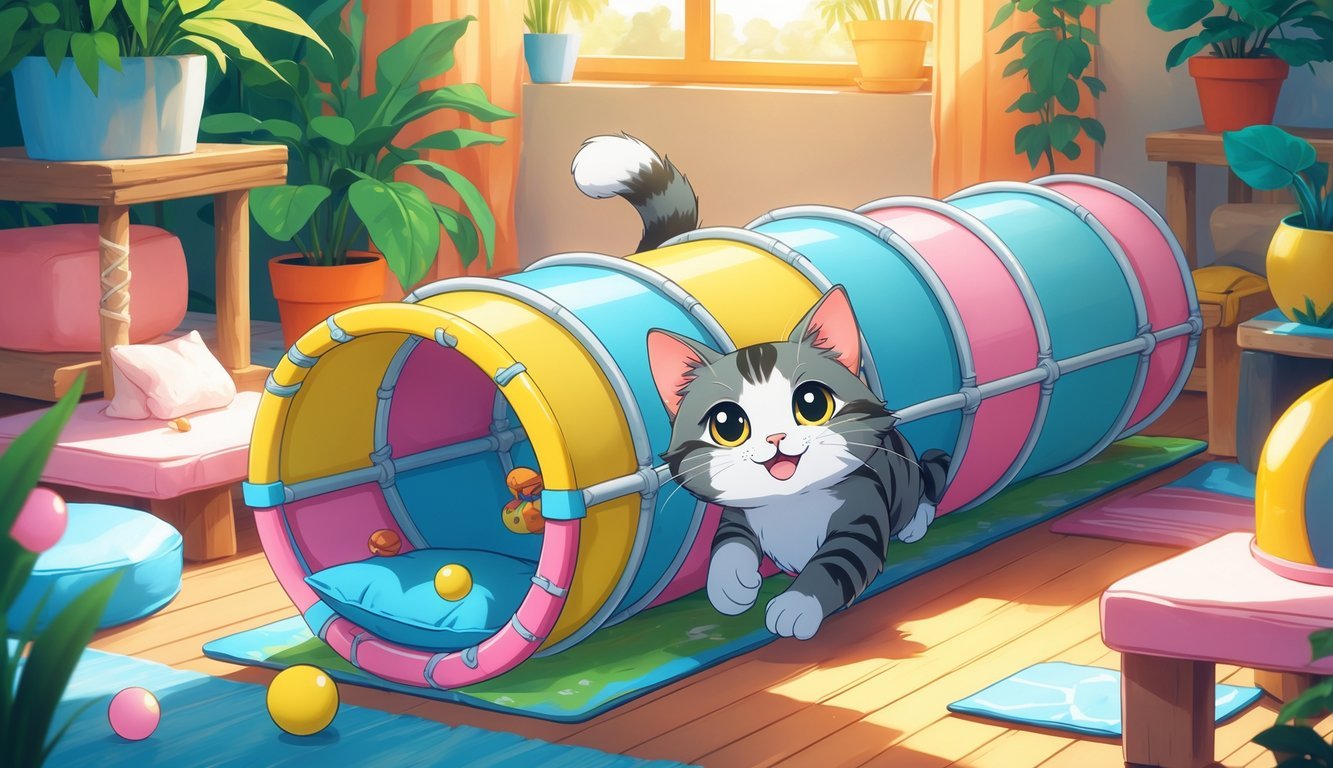
You can make a cat tunnel out of PVC pipes, connectors, and some fabric or carpet. PVC is light, cheap, and easy to work with—no fancy tools needed.
Build a basic frame with straight pipes and elbow joints. Once it’s sturdy, wrap it with fabric, carpet, or even flexible tubing to make the tunnel walls.
Your cat will love crawling through, hiding, or just using it as a shortcut. Keep it short for indoor play, or make it longer if you want to use it outside.
Want to mix things up? Connect a few tunnels together or link them to a play area. Your cat gets exercise and a safe place to explore.
PVC tunnels are easy to move and clean, so they’re super practical. Adjust the size or shape whenever you want to fit your space or your cat’s mood.

A floating cat ledge with steps gives your cat a safe way to get up high and chill. Mount the ledge on a wall and add steps or small shelves leading up. It’s perfect for cats who love to climb.
You don’t need a bunch of tools. Just some sturdy wall brackets, wood boards, and screws. Make sure the boards are wide enough for your cat to sit or sprawl out.
Cover the ledge and steps with carpet or a non-slip mat so your cat feels secure. This also helps protect the wood from scratches.
Put the ledge where your cat can watch the room or peek outside. Cats love high places where they can see everything.
If you have more than one cat, add extra steps or ledges at different heights. Each cat gets its own space, and you’ll have fewer squabbles.
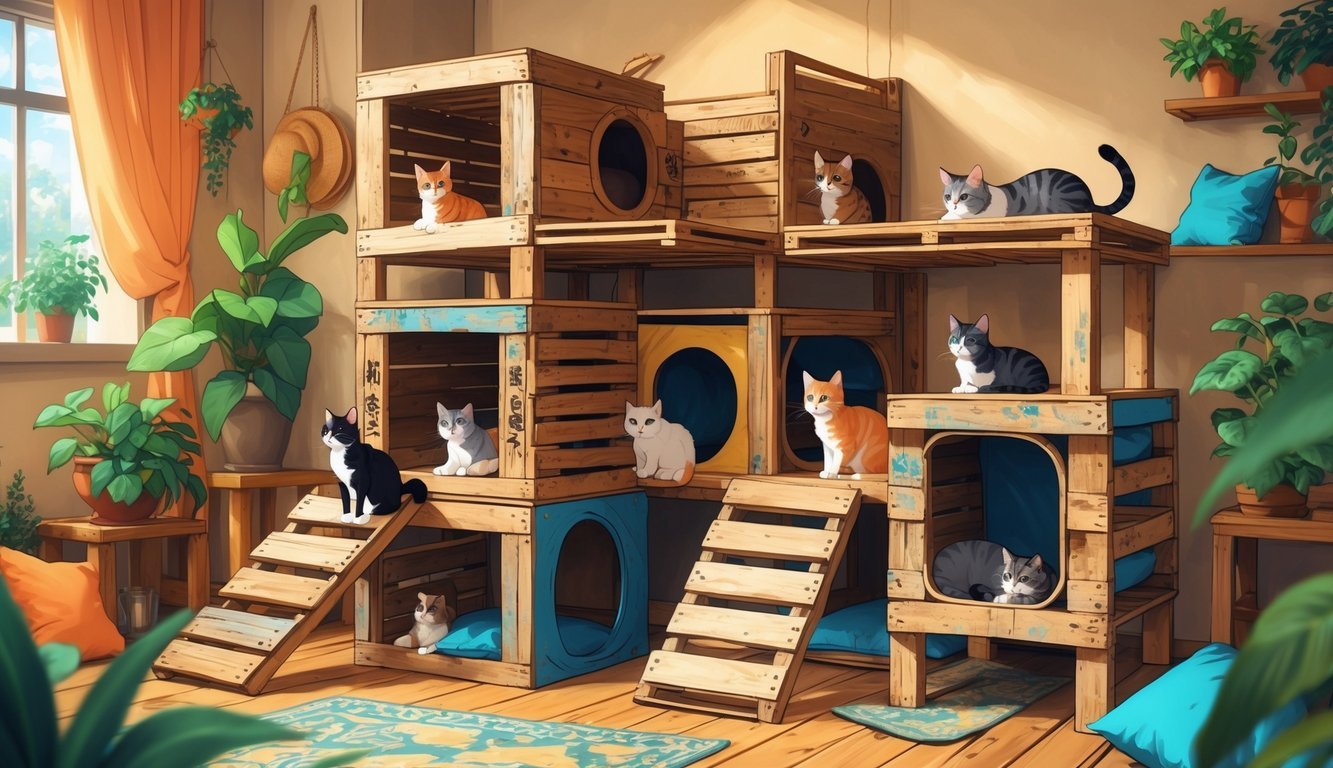
Old wooden pallets can become a sturdy, budget-friendly cat condo. Pallets are easy to find, and you can turn them into a cool cat hangout with a bit of elbow grease.
Sand down the wood to get rid of rough spots. This keeps your cat safe from splinters. Cut and stack pieces to make different levels for climbing and lounging.
Add enclosed spaces for cozy hideouts. Cats love curling up in small, private spots. Line these with soft fabric or an old blanket.
Attach scratching posts made from rope or leftover carpet for even more fun. Your cat gets a place to scratch that isn’t your couch. Add ramps or steps to make climbing easier.
Want to brighten it up? Paint the wood with pet-safe paint. It adds personality and keeps the condo looking sharp. With a little creativity, you’ll end up with a custom cat playhouse that fits your space and your cat’s quirks.
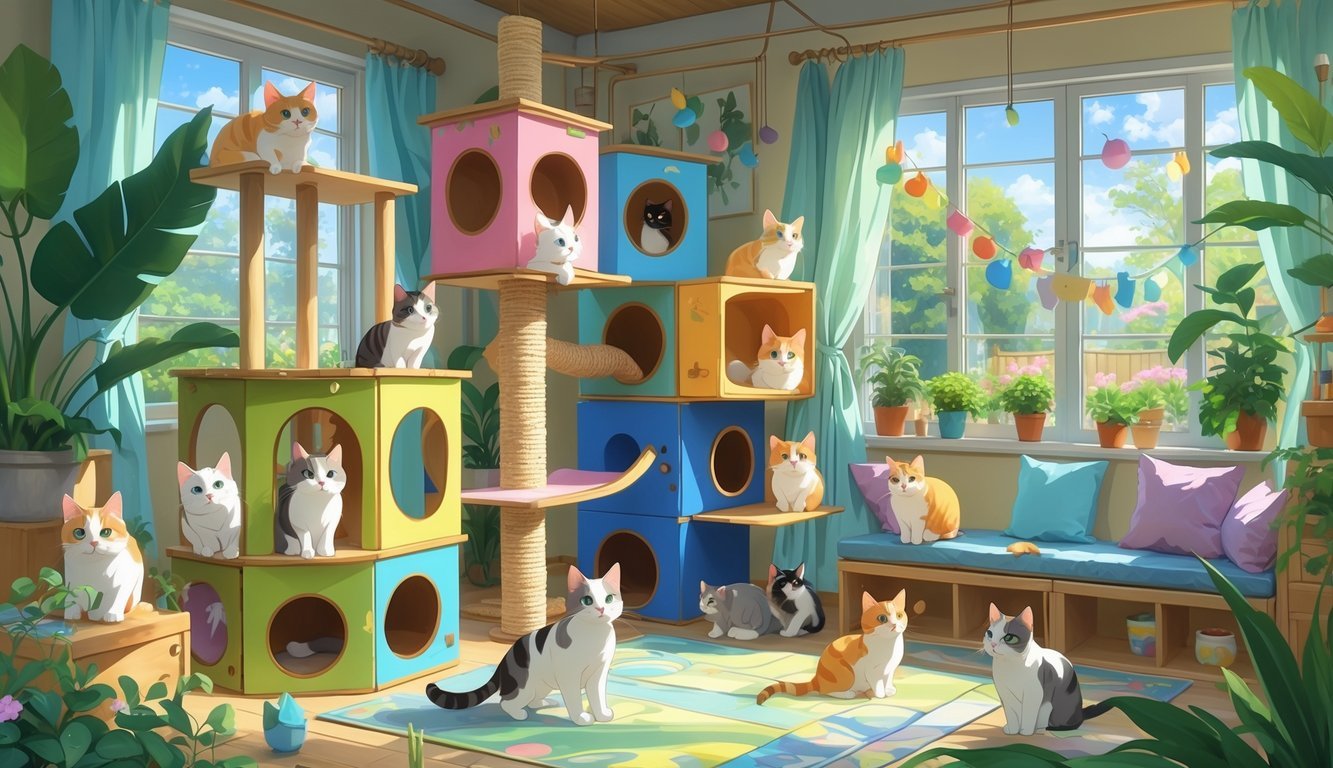
When you build your own cat furniture, you get more than just a weekend project. You create pieces that fit your cat’s habits and save money compared to store-bought options.
Cats love to climb, scratch, and hide. If you make your own furniture, you can add features that fit your cat’s instincts.
A tall perch lets them climb and jump. A cozy cubby gives them a safe spot to retreat.
It’s pretty easy to add scratching posts using sisal rope or carpet. This protects your furniture and gives your cat a healthy way to burn off energy.
You can design pieces that encourage play, too. Ledges, ramps, or hanging toys keep your cat active indoors.
These features help fight boredom and might even prevent some unwanted behavior.
When you tailor the design, you pick the size, shape, and where it goes. Your cat ends up with furniture that matches their personality—maybe they love lounging, or maybe they’re a climber or a hider.
Store-bought cat trees and towers? They’re expensive. Sometimes a single piece costs over $100, and the big ones can be way more.
If you use wood, PVC pipe, or old furniture, you can build something similar for a lot less.
You’ll save even more by reusing things you already own. Old shelves, scrap wood, or cardboard boxes can turn into sturdy, fun cat furniture.
Here are a few cheap ideas:
DIY projects are flexible. You get to decide your budget, pick your materials, and match the piece to your home’s style.
In the end, you create something useful and nice-looking—without spending a fortune.
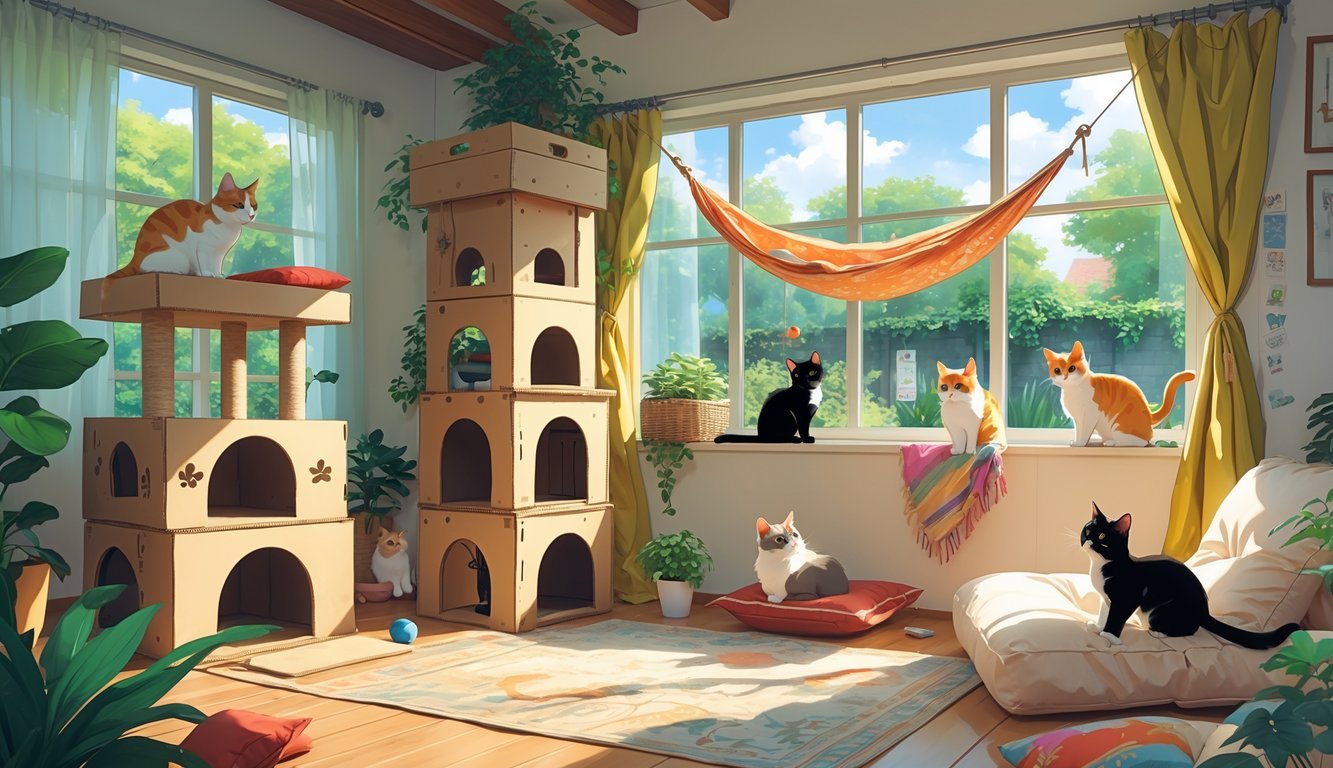
Your cat will definitely climb, scratch, and probably chew whatever you build. You’ve got to pick safe supplies and make sure everything stays sturdy.
The right materials and careful building will help prevent injuries and make your project last longer.
Always go for non-toxic materials—cats lick and chew way more than you’d think. Untreated solid wood works well for frames and platforms.
Skip pressure-treated lumber because it often contains chemicals that could harm your cat.
For coverings, stick with natural fabrics like cotton, sisal, or wool. They’re tough and safe for scratching.
Old carpet can work, too, but make sure it’s clean and free of glue or chemical treatments.
When you attach fabric or rope, use pet-safe glue or staples that you fully secure. Make sure nothing sticks out, since loose staples or nails can hurt paws.
If you use rope, sisal rope is the best choice—it’s durable and cats love to scratch it.
For paints and finishes, pick low-VOC, water-based, and non-toxic options. Avoid varnishes or stains with strong fumes—cats are sensitive to smells and chemicals, so it’s not worth the risk.
Cats just love to climb, don’t they? That’s why you really need a stable tower. If the thing wobbles, your cat might get spooked, or worse, it could tip over.
Start out with a wide, heavy base. That’s what keeps the whole thing balanced, especially when your cat’s up top.
Grab some screws instead of nails for the frame. Screws just hold up better in the long run. If you want to go the extra mile, toss in some corner brackets or L-braces where the stress hits hardest.
Keep those platforms and shelves evenly spaced. Your cat needs to climb up without slipping or missing a step. Give each level a good press with your hand before you let your cat try it.
If you’re building something tall, push it up against a wall. Use wall anchors or brackets to make sure it can’t tip over. That’s a must, especially if your cat likes to leap around like a maniac.
Take a look at your handiwork every few weeks. Check for loose parts, frayed rope, or any sharp edges hiding out. A quick inspection keeps things safe and comfy for your cat.